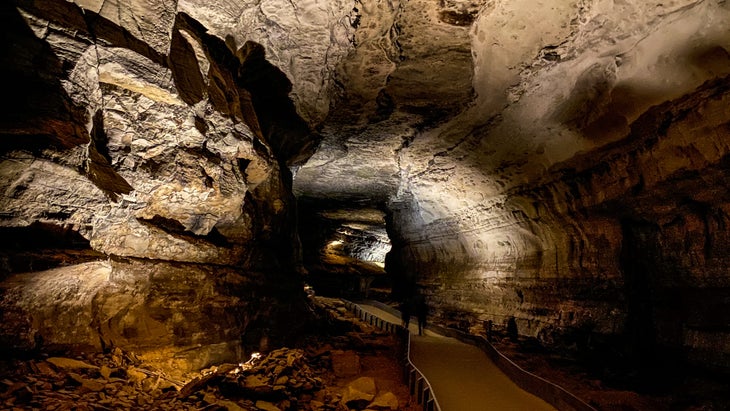
63 Parks Traveler started with a simple goal: to visit every U.S. national park. Avid backpacker and public-lands nerd Emily Pennington saved up, built out a tiny van to travel and live in, and hit the road, practicing COVID-19 best safety protocols along the way. The parks as we know them are rapidly changing, and she wanted to see them before it’s too late. Mammoth Cave is her 51st park visit.
It was raining when I arrived at Mammoth Cave in late October, a cool downpour making its way through the fading orange leaves of the surrounding deciduous forest. The gray Kentucky weather matched my mood perfectly. Exhausted after spending eight months on the road, my lack of sleep had finally caught up to me and dulled my usually cheerful spirit. I was thrilled to indulge my inner emo teenager while visiting a national park for once, embarking on a trip through the world’s longest-known cave system and into the dark bowels of the earth.
A small, gentle waterfall dripped into the gaping mouth of the cavern as I made my way down the stairs on a self-guided tour of the park’s most famous rooms. In no time at all, it was eerily black. The occasional amber tinge emitted by the cave’s minimal light fixtures illuminated craggy walls striped with ancient water marks, and a tiny bat slept upside down to my right as I moved through a narrow passageway and felt my knees buckle when I arrived at the next chamber.

The Rotunda Room is one of the largest in the cave, and as I stared up, slack-jawed, at its enormous domed ceiling, I overheard a ranger whisper that it’s big enough to hold a 737 aircraft. The park was certainly living up to its name.
In spite of its lavish opera-house good looks, the room was once used for quite another industry, one that contributed to uncountable deaths. Thanks to bats that had inhabited the cave for thousands of years, the dirt floor was once covered in guano, a substance rich in calcium nitrate, making the site ripe for the extraction of saltpeter—one of the primary ingredients used to make black gunpowder, and throughout the War of 1812, a profitable mining operation had sprung up inside Mammoth Cave to keep up with demand.
I walked silently through the colossal passageway, a blown-out mining site wrecked and vacant on my left. Rubble and ruin, I thought to myself, the spoils of war.
Though the cave itself was truly massive, it didn’t have the same drippy, psychedelic rock formations I’d seen in Carlsbad Caverns months earlier. With a bedrock of sandstone and shale, two minerals less water soluble than limestone, the area didn’t lend itself to the familiar stalactites and stalagmites of other subterranean tunnels. Instead, Mammoth Cave was mostly formed by a large, underground river that slowly carved out over 420 miles of halls and rooms, with more still being formed each day as new waters erode the hidden depths.
As if spending my morning underground wasn’t spooky enough, I soon passed a series of roofless stone buildings, evidence of an abandoned tuberculosis ward that once operated in the large tunnel. Believing the steady temperature and humidity to have curative properties, Dr. John Croghan brought a company of 16 withering patients into the caverns to see if his theory held. Five of them died inside the cave.
When the rain abated, I ditched the netherworld and set off for a short hike along the Cedar Sink Trail, shuffling my feet along the forest floor to a deep depression in the earth where part of the ancient cave had collapsed. A small brook churned out from below the mossy coliseum of rock, and a groundhog rustled nearby in the grass. I gazed up at the clouds and smiled in perfectly gloomy reverie.

63 Parks Traveler Mammoth Cave Info
Size: 52,830 acres
Location: Central Kentucky, northeast of Bowling Green
Created In: 1941 (national park)
Best For: History buffs, short hikes, cave tours, paddling
When to Go: Spring (39 to 81 degrees) and fall (40 to 85 degrees) afford the most temperate weather for hiking and paddling aboveground, while summer (64 to 91 degrees) is hot and humid, and winter (29 to 53 degrees) brings fewer crowds. The cave’s temperature remains a constant 54 degrees, though, and the park’s most popular tours run year-round.
Mini Adventure: Take a self-guided tour of the caverns. For visitors who don’t like narrow passageways or are short on time, this DIY stroll through some of the park’s most famous limestone formations and passageways will take you past historic saltpeter mines, archeological sites, and the 19th-century tuberculosis ward.
Mega Adventure: Spend a solid day on the guided Grand Avenue Tour. This four-hour ranger-led walk combines the Frozen Niagara and Domes and Dripstones Tours for a comprehensive showcase of Mammoth Cave’s geologic diversity. Squeeze through slot canyons, marvel at sparkling walls coated with gypsum, and meander through immense underground tunnels.
The post Mammoth Cave National Park Is Spooky yet Stunning appeared first on Outside Online.
by tzemke via Outside Online
Comments